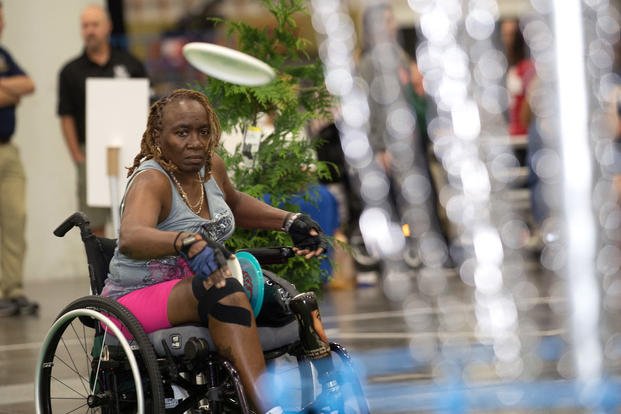The Department of Veterans Affairs has made significant progress in providing medical treatment and services to female veterans, but shortfalls still exist, especially in mental health care, largely as a result of gender differences, according to a new report from the nonprofit group Disabled American Veterans.
More than 600,000 female veterans receive health care through the VA, and the proportion of those who have a service-connected disability has risen since 2000 from 48% to 73% in 2020. Given that there are more than 2 million female veterans in the U.S., many of whom need support and qualify for VA services but aren't using their benefits, the department should do more to improve services for them, DAV analysts wrote in "Women Veterans: A Journey to Mental Wellness."
Jennifer Alvarado, a Navy veteran and domestic violence survivor, said at an event Tuesday about the report that it's important that VA officials "keep letting my fellow sisters in arms be seen."
Read Next: VA Won't Cover Gender-Affirmation Surgery for Transgender Veterans Until It Reviews PACT Act Effects
"I actually left the VA health care system for nearly eight years because at that point it was such a strain on my mental health," Alvarado said at a DAV event at the U.S. Capitol in Washington, D.C. "I could not deal with the inconsistencies and having lack of continuity of care, the sexual harassment of going in and out."
Now though, she said that, with the help of the DAV and VA health care system, she feels "hope and love" that female veterans will one day have what they deserve and what they earned and fought for.
Women veterans often struggle with complex medical needs, as well as mental health conditions. According to the report, the VA has seen a 154% increase in female patients seeking mental health services.
But much of the behavioral health care provided by the VA is based on research and experiences of male veterans, leaving out critical factors affecting women veterans that could help improve care and quality of life and decrease suicide, the analysts wrote.
For example, the REACH VET -- Recovery Engagement and Coordination for Health-Veterans Enhanced Treatment -- approach to suicide prevention helps identify veterans who may benefit from enhanced services, outreach and suicide risk assessment.
But it is based on male factors of risk and mental health and doesn't include military sexual trauma, a known factor for suicide risk in female veterans, or other conditions such as deployment-related depression that also play a role, the report notes.
Speaking at Tuesday's event, Susan Strickland, the associate director of research and program evaluation in the VA's suicide prevention office, said the department is already working on updating the REACH VET model to better incorporate female-specific health factors and military sexual trauma.
The VA also is required by law to maintain data on the mental health services and suicide prevention programs that are most effective for women, and while it does so, the information is not public, leaving the veteran community "with an incomplete understanding of the investments, outputs and outcomes of the VA suicide prevention strategy for women," the report said.
Women veterans are twice as likely as their male counterparts to attempt suicide and three times more likely than female civilians to choose the most lethal method, a firearm, to end their lives.
The DAV believes that the VA should modify its suicide prevention messaging campaigns to target women veterans and create a new position that would focus exclusively on the prevention of suicide among its female patients.
The VA runs a Center for Women Veterans to advocate for women and programs for female veterans within the system, as well as to educate and support beneficiaries regarding their benefits, services, educational and employment opportunities.
The VA's Women's Health Research Network has a Women Veterans Suicide Prevention Research Work Group to examine how sex and gender differences affect women's suicidal ideation. DAV analysts praised the research to date but urged the department to include more participants, including women and other minority groups at the VA to address any gaps.
In addition to suicide prevention, the VA should pay special attention to medical issues more common in women that could affect their mental or physical health, such as sexual trauma or domestic violence, reproductive health care, menopause and eating disorders, the report noted.
And, DAV analysts said, given the growing population of female veterans, who make up 18% of today's active-duty force, the VA will need to make continued investments in women-centered programs and services to meet their lifelong needs.
"The VA has made appreciable gains on how it can better serve women veterans since DAV's last report in 2018," the analysts wrote. "Many women who use VA care find it a positive experience, and the vast majority of them, across age groups, say they would recommend the VA to other women veterans. At the same time, where shortfalls exist, corrective actions must be taken."
Senate Veterans Affairs Committee Chairman Jon Tester, D-Mont., said the report will be helpful for his panel to craft legislation to improve VA mental health services for women. The committee is also planning a hearing on female veterans' issues in April, he said.
"DAV's findings and recommendations on supporting military sexual trauma survivors and rural women veterans will be especially helpful in guiding future legislation," Tester said at the DAV report rollout event. "That's what we've got to keep our eyes focused on, making sure the VA continues to improve and meet the needs of every veteran that comes home."















